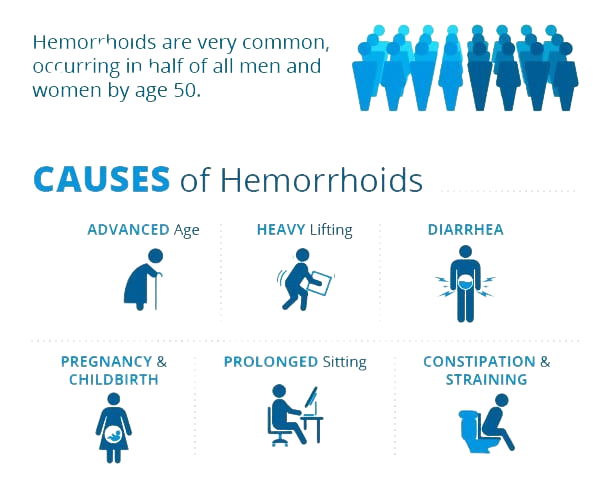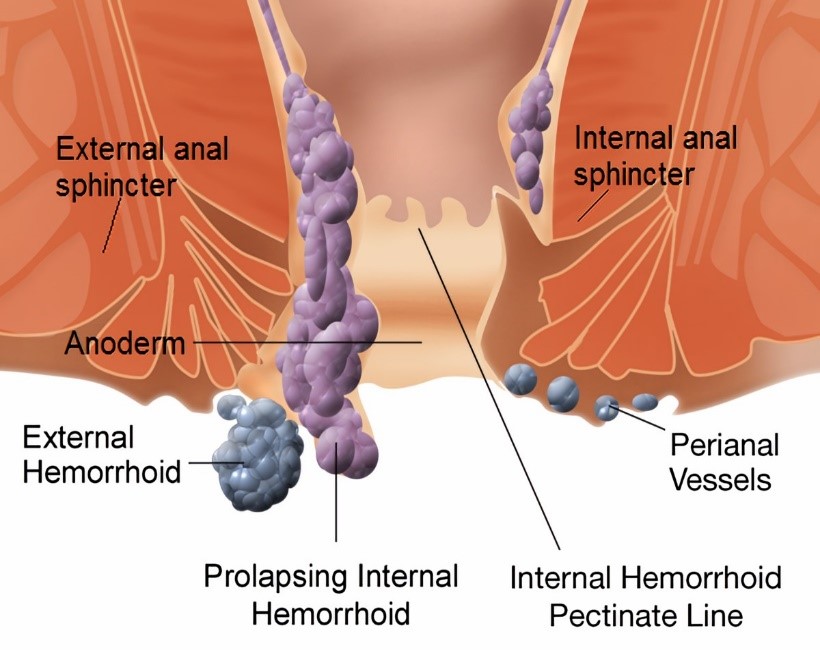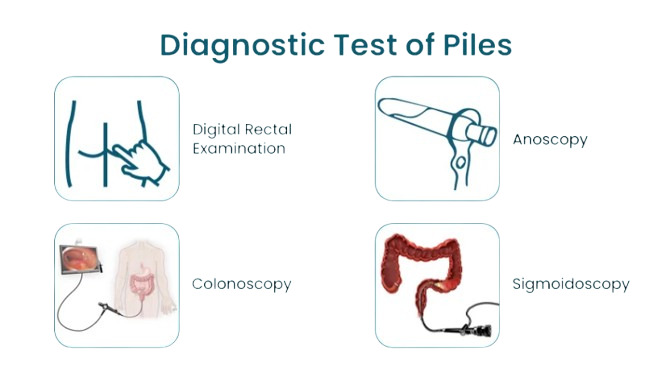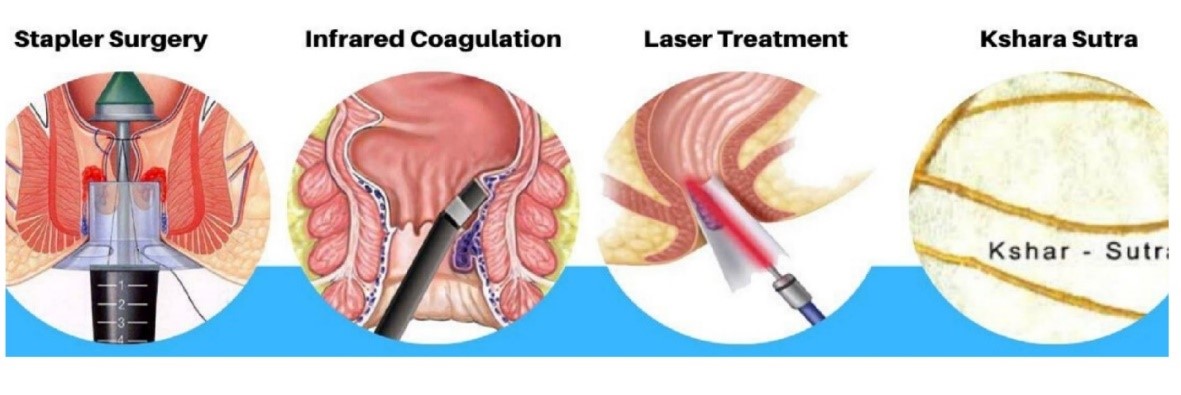What is Hemorrhoids or Piles

Hemorrhoids, commonly referred to as piles, are engorged veins located in the anal region and the lower rectum.Various treatment options exist for managing hemorrhoids.
A significant number of individuals find relief through home remedies and modifications to their lifestyle
Risk Factors

Hemorrhoids can affect individuals of all ages, including teenagers, although they are relatively rare in children due to the time required for their development. Certain factors may increase the likelihood of experiencing symptomatic hemorrhoids, such as:
- Being overweight or obese.
- Being pregnant: Throughout pregnancy, the growing weight of the fetus and uterus exerts pressure on the pelvic region. As a result, hemorrhoids may develop in as many as 35% of women who are pregnant.
- Consuming a diet low in fiber.
- Suffering from chronic constipation or diarrhea.
- Frequently lifting heavy objects.
- Spending extended periods sitting, especially on the toilet.
- Straining during bowel movements.
- Aging: Hemorrhoids predominantly occur in adults aged 45 to 65 years. Nevertheless, individuals who are younger, including children, can also experience this condition.
Types of Hemorrhoids with Symptoms
Hemorrhoids can occur either internally or externally in relation to the rectum, with the classification depending on the location of the swollen veins. The types are as follows:

- External: Swollen veins develop beneath the skin surrounding the anus, which is the passage through which feces are expelled. External hemorrhoids may cause itching and discomfort, and they can occasionally bleed. In some cases, they may become engorged with blood, leading to clot formation. While this condition is not hazardous, it can result in pain and swelling.
- Internal: Swollen veins arise within the rectum, the segment of the digestive tract that links the colon (large intestine) to the anus. Although internal hemorrhoids may lead to bleeding, they typically have no pain.
- Grade 1: Hemorrhoids are confined within the rectum and do not protrude.
- Grade 2: Hemorrhoids protrude during defecation but spontaneously retract afterward.
- Grade 3: Hemorrhoids are protruding and necessitate manual reinsertion.
- Grade 4: Hemorrhoids are protruded and cannot be reinserted.
- Prolapsed: Hemorrhoids, whether internal or external, can prolapse, meaning they extend and protrude outside the anus. Such hemorrhoids may cause bleeding or discomfort.
Diagnosis and Tests

The diagnosis of hemorrhoids is conducted by a healthcare professional through an assessment of symptoms and a physical examination. Additional procedures may include:
- A digital rectal examination, during which the provider inserts a gloved and lubricated finger into the rectum to detect any swollen veins.
- An anoscopy, where the provider employs an anoscope, a lighted instrument, to inspect the lining of the anus and rectum.
- A sigmoidoscopy, utilizing a sigmoidoscope, which is a lighted tube equipped with a camera, to examine the lower section of the colon and rectum.
- A colonoscopy may be conducted to validate the results of previous tests or to investigate potential indications of colon cancer.
Complications of Hemorrhoids:
Hemorrhoids may lead to discomfort and pain; however, they generally do not result in severe complications. In rare instances, individuals suffering from hemorrhoids may experience:
- Anemia.
- Blood clots in external hemorrhoids.
- Infections.
- Skin tags (a piece of tissue that protrudes from the skin).
- Strangulated hemorrhoids (where the muscles in the anus restrict blood flow to a prolapsed internal hemorrhoid).
How to Treat Hemorrhoids
Non-Surgical:
Hemorrhoids frequently resolve independently without the need for medical intervention. Symptoms such as discomfort and bleeding may persist for approximately one week or slightly longer. During this period, the following measures may help alleviate symptoms:
- Apply over-the-counter treatments that contain lidocaine, witch hazel, or hydrocortisone to the affected region.
- Increase your water intake.
- Enhance your dietary fiber consumption through food and supplements, aiming for a daily intake of 20 to 35 grams.
- Soak in a warm bath (sitz bath) for 10 to 20 minutes each day.
- Use laxatives to soften stools.
- Consider nonsteroidal anti-inflammatory drugs (NSAIDs) to manage pain and inflammation.
- Utilize toilet paper with lotion or flushable wet wipes to gently clean the area after bowel movements. Alternatively, a tissue or washcloth dampened with water may be used.

Surgical Treatment:
It is advisable to consult your healthcare provider if your symptoms worsen or significantly disrupt your daily activities or sleep patterns. Additionally, seek medical assistance if there is no improvement after one week of self-treatment. Your healthcare provider may consider the following treatments for hemorrhoids:
- Rubber band ligation: This procedure involves placing a small rubber band around the base of the hemorrhoid, effectively cutting off its blood supply.
- Electrocoagulation: This method utilizes an electric current to halt blood flow to the hemorrhoid.
- Infrared coagulation: A small probe is inserted into the rectum to deliver heat, which aids in eliminating the hemorrhoid.
- Sclerotherapy: A chemical agent is injected into the affected vein to destroy the hemorrhoid tissue.
- Hemorrhoidectomy: This surgical procedure involves the removal of large external hemorrhoids or prolapsed internal hemorrhoids.
- Hemorrhoid stapling: A stapling device is used to excise an internal hemorrhoid or to reposition a prolapsed internal hemorrhoid back into the anus, securing it in place.


Prevention

As individuals age, the occurrence of hemorrhoids becomes more prevalent. To help prevent the formation of hard stools and constipation, which can contribute to hemorrhoids, consider the following recommendations:
- Limit the duration of time spent sitting and avoid excessive straining during bowel movements.
- Respond promptly to the urge to use the restroom; delaying bowel movements can exacerbate issues.
- Ensure adequate hydration by drinking sufficient water throughout the day.
- Incorporate more high-fiber foods into your diet, such as fresh fruits, vegetables, and whole grains, or consider fiber supplements. It is generally advised that women and individuals assigned female at birth aim for 25 grams of fiber daily, while men and individuals assigned male at birth should target 35 grams.
- Maintain an active lifestyle, as regular physical activity promotes healthy bowel function.
- Use laxatives or enemas strictly as directed by your healthcare provider, as overuse can disrupt the body's natural ability to regulate bowel movements.
When to Seek Help
It is advisable to contact your healthcare provider if you suspect the presence of hemorrhoids and are experiencing any of the following symptoms:
- Abdominal discomfort.
- Persistent constipation or diarrhea.
- Fever accompanied by chills.
- Nausea along with vomiting.
- Intense rectal bleeding and pain.























